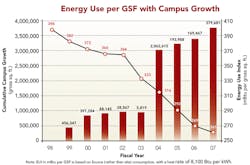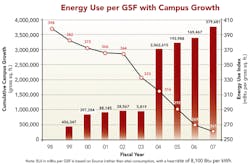Optimize Building Systems with Commissioning
By Steve Harrell
Energy topics, such as high costs, uncertain supply, and energy sources, have risen to the top of the agenda in the boardroom for every building owner. According to the U.S. Department of Energy (DOE), commercial office buildings lead the industrial and transportation sectors in total usage of kilowatt hours (kWh), and show no signs of slowing down.
Almost all new buildings today are designed with energy efficiency in mind. Variable frequency drives (VFDs), chillers with low kW/ton power requirements, and highly sophisticated building-automation systems are typically designed into most commercial office buildings, hospitals, and schools. Simply designing and installing these technologies, however, isn't enough if energy usage is to be optimized over the long term.
In a study of 60 new buildings, conducted by the Berkeley, CA-based Lawrence Berkeley National Laboratory (LBNL), 50 percent suffered controls problems, 40 percent suffered HVAC problems, 15 percent had missing equipment, and 25 percent of the economizers and VFDs didn't function. In addition, 60 percent of all insurance claims were HVAC related; the No. 1 source of complaints was HVAC.
Remember, this was a study done on new buildings. If a similar study were conducted for existing buildings, they would probably fare far worse due to the natural degradation of HVAC systems and the inherent changing conditions in buildings over time.
Building commissioning, recommissioning, and retro-commissioning are valuable services offered by firms to remedy problems like those from the LBNL study, which are faced in the operation and optimization of building systems, including HVAC.
What Sets Retro-Commissioning Apart?
Building commissioning, as defined by the 2007 ASHRAE Handbook - HVAC Applications, is "a quality-oriented process for achieving, verifying, and documenting that the performance of facilities, systems, and assemblies meets defined objectives and criteria. The defined objectives and criteria are often referred to as the owner's project requirements (OPR) ... "
The focus for performance is placed primarily on HVAC systems, such as central heating and cooling (chillers, boilers, and associated pumps), air-handling units, terminal equipment, and HVAC-control systems. (Attention should also be given to lighting systems [fixtures and controls] and water systems.)
With today's environmental, economic, and energy challenges, building owners shouldn't take ownership of a building that hasn't been commissioned by a proper commissioning authority.
Recommissioning, as defined by the 2007 ASHRAE Handbook - HVAC Applications, is applying "commissioning to a project that has been previously delivered using the commissioning process."
Finally, the Atlanta-based American Society of Heating, Refrigerating and Air-Conditioning Engineers (ASHRAE) states that "existing building commissioning, often called ‘retro-commissioning,' applies commissioning to an existing facility that may or may not have been previously commissioned."
The definitions of commissioning and recommissioning seem clear: Verify that the HVAC and electrical systems are in accordance with the original design intent/plans and specifications. Retro-commissioning, however, takes on that same meaning in addition to others, which include optimization of HVAC/electrical systems and energy-reduction strategies, each of which may vary from the original design intent, but is deemed beneficial given the changing operating conditions within the building. While the importance of definition seems irrelevant at first, it's crucial that the deliverables of the commissioning authority/agent are in line with client expectations.
Because of the varying definitions and interpretations of retro-commissioning, the process can be defined in as many ways as there are firms that provide the service. A typical process, however, should consist of:
- A planning phase, which consists of an initial walkthrough, team formation, and a kickoff meeting.
- An investigation phase to review existing documentation and perform functional testing and monitoring to develop a master plan.
- An implementation phase to execute changes, make improvements, and verify the results.
- A project closeout phase to write and deliver final results.
An Internet search for "retro-commissioning" would indicate that it has evolved to include building performance optimization. Benefits of retro-commissioning are numerous and predictable: It minimizes excessive equipment repair/replacement, reduces employee absenteeism and tenant turnover, improves indoor air quality, and, most importantly, reduces energy costs. If the U.S. Green Building Council's LEED for Existing Buildings: Operations & Maintenance (LEED-EB O&M) certification is a goal, retro-commissioning can contribute up to 24 percent of the total points needed for certification.
HVAC systems must be operated at the optimum level based on the building's current conditions and comfort requirements. Too often, within the first few years of operation, new buildings that were formally and properly commissioned wind up with Energy Use Indexes (EUIs) that are three or four times higher than the industry standard.
One contributing factor is that system components often fail or deteriorate over time. With today's sophisticated BASs, this deterioration is often hidden or unnoticed because the controls have "learned" or "adapted" to the changing conditions of the building and/or HVAC equipment. This can increase operating costs by as much as 50 cents per square foot per year.
Savings for 10 Buildings at Texas A&M | |||
| Building | Baseline Use | 2-Year Average Simple Payback on Savings 1998, 2000 | 2-Year Average |
| 1 | $484,899 | $280,687 | 1.73 |
| 2 | $229,881 | $113,391 | 2.03 |
| 3 | $283,407 | $66,371 | 4.27 |
| 4 | $315,404 | $105,137 | 3.00 |
| 5 | $145,420 | $56,657 | 2.57 |
| 6 | $192,019 | $59,308 | 3.24 |
| 7 | $273,687 | $120,706 | 2.27 |
| 8 | $324,624 | $90,001 | 3.61 |
| 9 | $224,481 | $57,990 | 3.87 |
| 10 | $436,265 | $139,010 | 3.14 |
| Total | $2,910,087 | $1,089,255 | 2.67 |
| Ten buildings on Texas A&M University's College Station, TX, campus documented savings between 1998 and 2000. When viewed as a group of 10 buildings, the average payback was 2.67 years. | |||
SOURCE: MODIFIED FROM A CHART APPEARING IN THE 2004 PAPER BY DAVID CLARIDGE, WD TURNER, SONG DENG, GUANGHUA WEI, CHARLES CULP, HUI CHEN, AND SOOLYEON CHO FROM TEXAS A&M'S ENERGY SYSTEMS LABORATORY, AND MINGSHENG LIU FROM UNIVERSITY OF NEBRASKA | |||
The Need to Continue Commissioning
Beyond the initial steps taken to ensure that building systems are operating at optimum levels, building owners and operators should recognize the need for - and value of - continually verifying that there has been no degradation in the HVAC system, and that it continues to operate at peak efficiency. Filter/belt changes on air-handling units and oil changes and bearing inspections on chillers are just the beginning of what should be done on a continuous basis to keep a building operating at optimum levels.
Today's buildings can benefit tremendously from not only retro-commissioning, but also from Continuous Commissioning®. While retro-commissioning is generally a one-time event, Continuous Commissioning is a continuous process of collecting and analyzing energy data via an existing BAS and/or standalone metering equipment, and making the necessary operational changes to keep building systems operating at optimal performance levels in future years.
Continuous Commissioning, as defined by Energy Systems Laboratory at College Station, TX-based Texas A&M University, is an ongoing, specific process used to resolve operating problems, improve comfort, and optimize energy use. This distinction between the goal of complying with original design intent and the goal of optimizing HVAC operation and control is very important to recognize and understand.
Adhering to the formal Continuous Commissioning process not only maintains the long-term savings potential, but also improves system reliability and building comfort as building conditions change. When Continuous Commissioning is properly implemented, reasonable expectations for paybacks and savings are between 20 and 30 percent in less than 3 years. Savings for 10 Buildings at Texas A&M, represents the documented savings of 10 buildings on Texas A&M University's campus between 1998 and 2000. When viewed as a group of 10 buildings, the average payback was 2.67 years.
The Continuous Commissioning process is implemented through a two-phase procedure. In the first phase, potential measures are identified, as well as the costs and projected savings of these measures. In the second phase:
- Energy and comfort baselines are established.
- Extensive and specific measures for improvements are identified and implemented.
- Changes are documented in accordance with Intl. Performance Measurement & Verification Protocol (IPMVP).
- Building staff is trained.
- Energy and comfort performance are tracked and verified for a minimum of 1 year in accordance with IPMVP.
Continuous Commissioning has been extensively utilized on the Texas A&M University campus and in buildings across the country over the last 15 years. A total cost savings of $60 million has been well documented, with an investment of approximately $10 million in Continuous Commissioning and $8 million in capital improvements. Their EUIs have been in steady decline since 1998 (see Energy Use per GSF with Campus Growth, below).
Choosing a Commissioning Firm
Since HVAC systems begin to degrade the moment they're installed, the appropriate time to consider retro-commissioning and/or Continuous Commissioning for an existing building that's never been commissioned is now; energy waste has almost certainly begun. In the case of a new building that's been commissioned and is still in the first-year warranty period, a Continuous Commissioning program should be ready for implementation immediately after the warranty period.
Firms offering retro-commissioning come from a variety of backgrounds, including engineering, general contracting, HVAC/controls contracting, commissioning specialists, TAB (testing, adjusting, and balancing) contracting, energy services, and O&M service contracting.
Building owners should consider obtaining retro-commissioning services from firms that specialize in building commissioning vs. firms that offer commissioning services as a small part of their total offering; Building Commissioning Association (BCA) membership adds additional credibility to the commissioning firm's qualifications. If Continuous Commissioning is preferred, Energy Systems Laboratory's authorized licensees offer additional expertise and credibility that meet or exceed the BCA's professional standards.
Because of the complexity of building systems and the continuous focus on energy supply and sustainability, retro-commissioning and Continuous Commissioning are especially advantageous: Both offer unique, easy-to-implement, and cost-effective solutions to reducing energy consumption in today's commercial buildings.
Steve Harrell is manager of Continuous Commissioning at Nashville, TN-based SSRCx, the commissioning subsidiary of Smith Seckman Reid, an engineering design and facility consulting firm.

